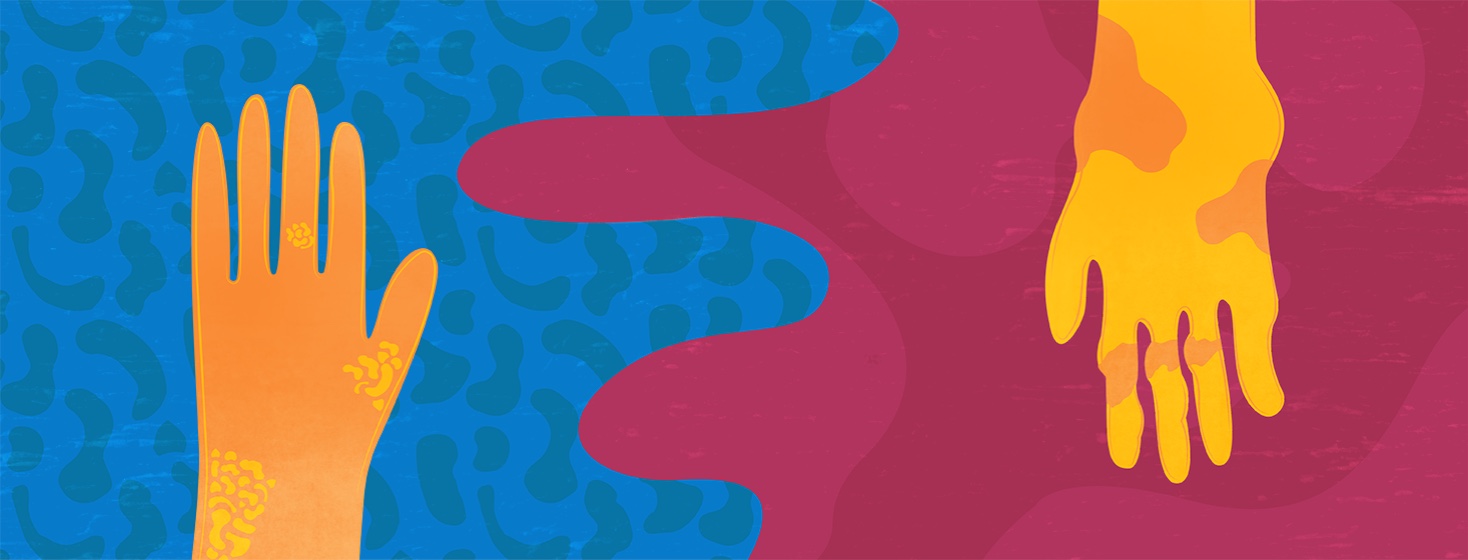Autoimmune Myositis versus Psoriatic Arthritis: Similarities & Differences
“Myopathy” is a term that means muscle disease. Inflammatory muscle diseases include polymyositis (literally, “inflammation of many muscles”) and dermatomyositis (“inflammation of the skin and underlying muscle”).
The different forms of myositis
Both forms of myositis cause muscle weakness. The weakness begins in the shoulders and hips. It usually worsens over weeks or months, although it may happen more quickly in rare cases.1 Due to weakness, patients have a difficult time with everyday tasks such as getting out of a chair, climbing stairs, and lifting objects.1 In advanced disease, patients may have trouble swallowing and breathing.
People with dermatomyositis have skin changes in addition to muscle weakness. Skin changes usually occur first.1 A blue-purple rash (“heliotrope rash”) may appear on the eyelids. A red rash may spread on the face, neck, and chest or on the back and shoulders. It may get worse after time in the sun and can be itchy. Gottron’s rash is a typical sign of dermatomyositis. Gottron’s rash looks like red to purple flat papules (bumps) on the knuckles.
Autoimmune myositis is uncommon and can be difficult to diagnose properly.1,2 Multiple other conditions are considered in the differential diagnosis.
How are myositis and psoriatic arthritis similar?
Myositis and psoriatic arthritis (PsA) are fundamentally different diseases. Myositis is a muscle disease, whereas PsA is a joint disease. However, these conditions do share some similarities:
Both are inflammatory conditions
Although the cause of either disease is unknown, both result from an abnormal immune reaction. Therefore, some of the same anti-inflammatory and immunosuppressant medications are used to treat both conditions. These medications include corticosteroids, azathioprine, methotrexate, and cyclosporine. Biologic medications have an established role in treating PsA, but are still investigational for inflammatory myopathy.3
Both are associated with skin changes
Many people with psoriatic arthritis also have psoriasis. The scaly, itchy red patches that characterize plaque psoriasis can look like the chronic Gottron rash seen in dermatomyositis.1,4
Both typically develop in middle age or later
PsA can develop at any age, but it most commonly develops between ages 30 and 50.5 Similarly, dermatomyositis can occur in children and polymyositis can develop in people as young as 18 years,1 but the typical onset of autoimmune myositis is age 40 to 60 years.6
Both interfere with activities of daily living
Both conditions can result in a loss of normal function in affected areas, making it difficult to perform everyday tasks. Although the impact on daily living are similar, the causes are different. In PsA, painful, swollen, and stiff joints can limit movement and mobility. In myositis, limitations result from weakness of the large muscles close to the center of the body (thighs, hips, and upper arms).
Overlap of some symptoms
Although muscle weakness is main symptom of autoimmune myositis, approximately 30% of people with myositis experience joint aches and inflammation.6 In contrast to PsA, joint pain and swelling in myositis is typically mild. PsA and dermatomyositis both can affect the nails, although the effects are different. Nail psoriasis may appear as pitting, crumbling, red dots, or oil drops. Dermatomyositis causes changes to the nail beds and thickened cuticles.1
How do they differ?
As noted previously, a key difference between myositis and psoriatic arthritis is that they are diseases of different body parts. Therefore, they differ in terms of symptoms and progression. Because PsA is far more common than myositis, more is known about its optimal treatment.
Differences in characteristic symptom patterns
PsA typically begins with joint pain and stiffness. Joints in the extremities (“distal joints”), such as the fingers and toes, are usually the first to be affected by PsA. PsA is often asymmetric, affecting a joint on one side of the body but not the other. Myositis is characterized by muscle weakness. In contrast to PsA, myositis first affects the muscles closest to the core, such as the shoulders and hips.1 Muscles in the hands, face, and feet are affected only late in the disease course1 or not at all.5 Weakness in myositis is usually symmetrical.
Differences in prevalence
PsA is considerably more common than myositis. The best estimates of prevalence per 100,000 individuals are 300 to 1000 cases of PsA7 and 0.6 to 1.0 cases of myositis.1
Differences in treatment
The goals of PsA treatment are symptom relief, slowing the progression of joint damage, maintaining mobility, and preventing disability. To this end, a variety of effective traditional, biologic, and targeted disease-modifying therapies have been studies and approved for PsA. The goals of myositis treatment are restoring muscle strength, reducing inflammation, and preventing damage to other organs.8 Few prospective randomized trials have been conducted on treatment of myositis. To date, no novel or disease-modifying treatments have been approved for myositis.

Join the conversation